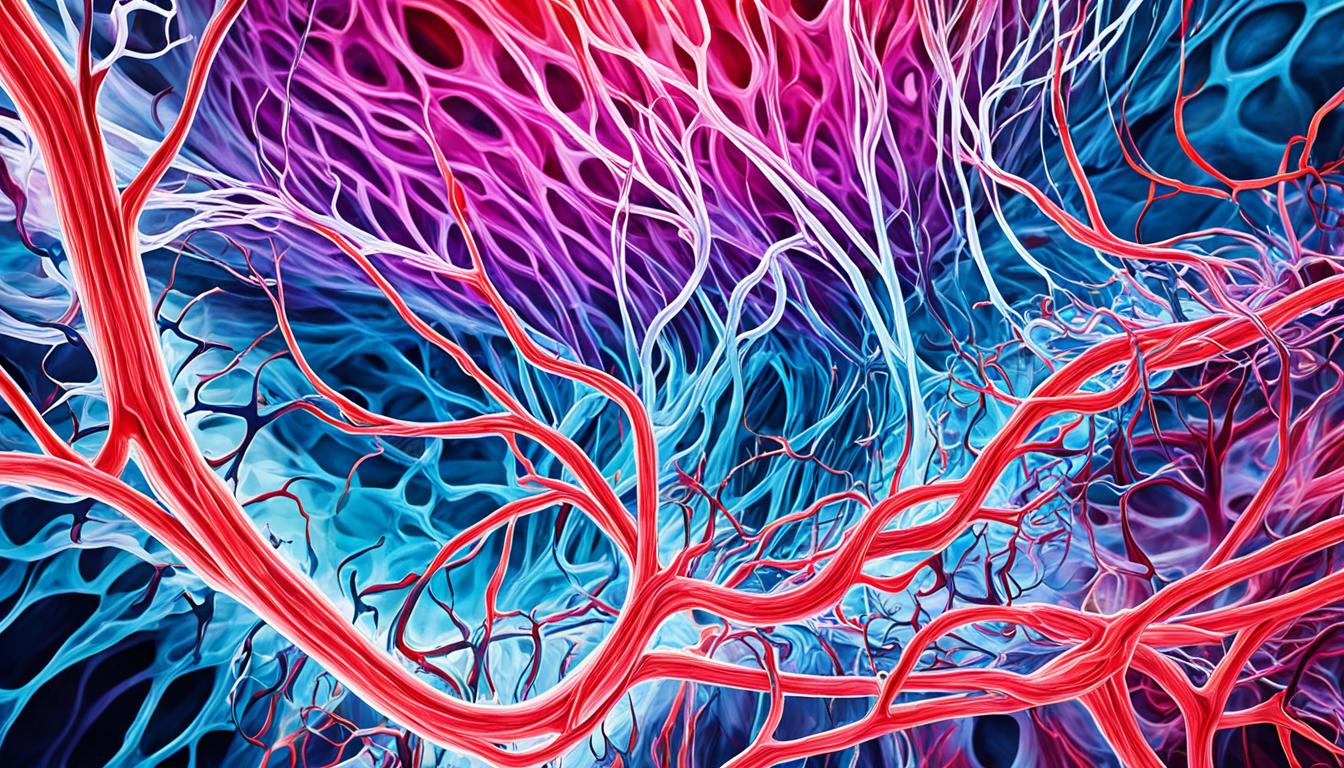A fistula arteriovenous (AV) is when an artery and a vein connect abnormally. This often happens around the brain or spinal cord. These conditions, called dural arteriovenous fistulas (DAVFs), are rare. They mostly affect people between 50 and 60 years old.
The cause of DAVFs isn’t always clear. They might be linked to problems like blockages in the brain’s veins. Symptoms can be different for each person. They might experience severe headaches or have trouble with movement, seizures, or vision.
There are a few ways to treat DAVFs. Doctors might use special procedures, focused radiation, or surgery to fix the abnormal connection. Recently, research has turned to stem cell therapy as a possible way to treat these issues.
Key Takeaways:
- Fistula arteriovenous (AV) is an abnormal connection between an artery and a vein.
- DAVFs in the brain or spinal cord are common types of fistula arteriovenous.
- DAVFs tend to occur in individuals between the ages of 50 and 60.
- Symptoms of DAVFs include sudden headache, trouble walking, seizures, speech or language issues, and vision changes.
- Treatment options for DAVFs can include endovascular procedures, stereotactic radiosurgery, or surgery to disconnect or remove the fistula.
- Stem cell therapy is being researched as a potential treatment for fistula complications.
Symptoms of Fistula Arteriovenous
The signs of a fistula arteriovenous (AV) can differ based on where and how big the fistula is. A bad AV fistula might lead to brain bleeding—this is called intracerebral hemorrhage. This can cause a sudden, intense headache. Other signs might include:
- Trouble walking
- Seizures
- Problems talking or understanding speech
- Facial pain
- Memory problems
- Slow movement and shaking
- Issues with coordination
- Feeling like your skin is burning or tingling
- Weakness
- Not wanting to do things you used to enjoy
- Trouble growing or developing as expected
- Signs of high pressure like headaches, feeling sick, or throwing up
Sometimes, an AV fistula can lead to ear or eye symptoms, and vision changes.
Examples of Symptoms:
If someone has an AV fistula, they might find walking hard. They could struggle to talk clearly or find the right words. And they could feel weak. They might also have a really bad headache all the time; this could mean their brain is bleeding. If not treated, these symptoms might cause lasting brain problems.
Symptoms Related to Increased Pressure:
When an AV fistula increases brain pressure, it shows in many ways. Headaches can be very bad and get worse slowly. Feeling sick and throwing up might happen, especially in the morning or after doing things. These signs show why finding and treating an AV fistula early is crucial.
Neurological deficits:
Sometimes, an untreated AV fistula can lead to lasting harms. These harms affect how well the nervous system works, like moving, thinking, and how well you can live your life. Treating the AV fistula early helps prevent these serious problems.
[[table]]
The provided data doesn’t include any information for the table in this section.
Causes and Risk Factors of Fistula Arteriovenous
The exact cause of fistula arteriovenous (AV) is often not known. It could be linked to various factors. These factors include:
- Traumatic head injury can damage blood vessels, leading to an AV fistula.
- Infection in the brain or spinal cord can cause an AV fistula to form in rare cases.
- Those who have had brain surgery in the past may be at a higher risk.
- Blood clots in deep veins, like the legs, make AV fistula formation more likely.
- Noncancerous tumors near the brain and spinal cord can also play a part.
Dural arteriovenous fistulas (DAVFs) affect the brain or spinal cord cover. They form when a brain venous sinus is blocked, causing abnormal vessel connections.
Several factors can make an AV fistula more likely. These include:
- People who are prone to vein blood clots have a higher risk.
- Noncancerous tumors near the brain and spinal cord can increase this risk.
- Age plays a role, with most cases occurring in people ages 50 to 60. But, they can also happen in younger individuals.
Knowing about the causes and risks of AV fistulas is crucial for diagnosis and care. Health professionals can use this knowledge to create prevention and treatment plans.
Stem Cell Therapy for Fistula Arteriovenous
In recent years, stem cell therapy has become a key player in treating fistula arteriovenous (AV) problems. Stem cells can turn into different kinds of cells, helping damaged tissues heal. This is especially useful for AV fistula patients.
Though we still need more studies on using stem cells for AV fistulas, early results are encouraging. Stem cell treatment might help blood vessels work better, fight inflammation, and start tissue regeneration. It shows promise in repairing the body.
Thailand has become a hotspot for patients seeking modern alternatives for AV fistulas. Here, advanced stem cell treatments give hope to those looking for the latest and most effective solutions. These treatments signify a big step forward for those with AV fistula troubles.

